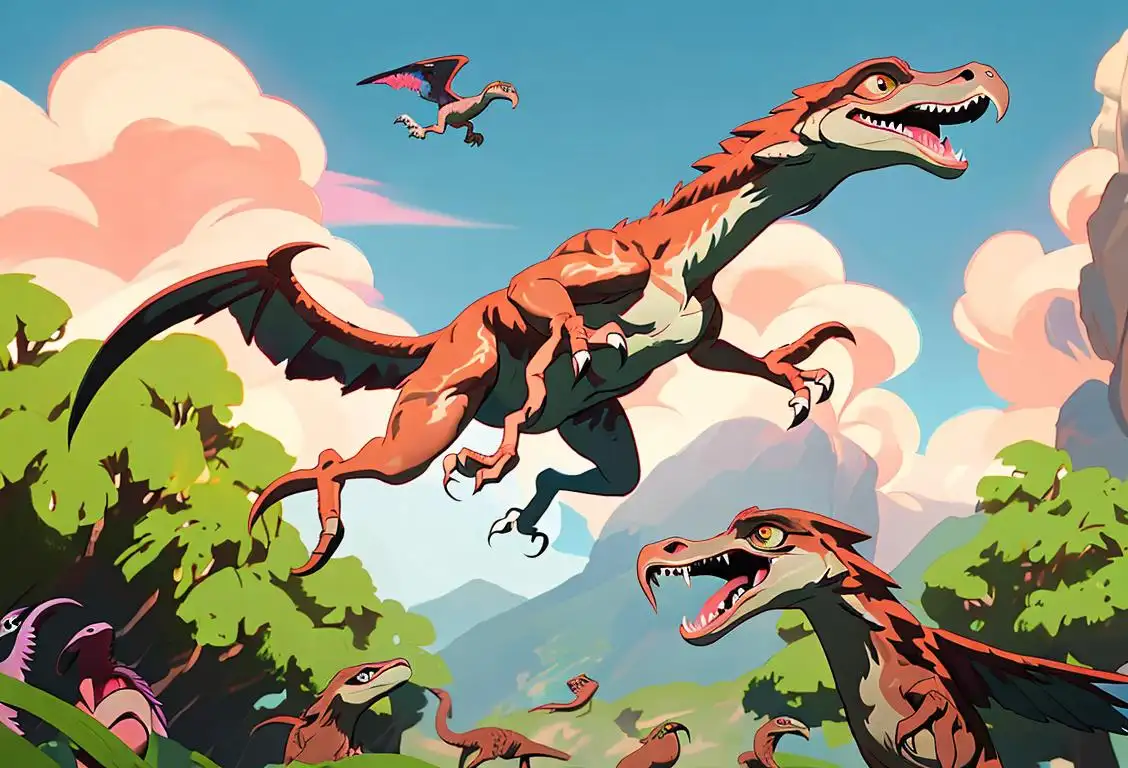National Velociraptor Day

Happy National Velociraptor Day! Get ready to dive into the fascinating history of this prehistoric celebration. Prepare to be amazed and entertained as we uncover the origins and fun facts about these speedy dinosaurs.
When is Velociraptor Day?
It's national velociraptor day on the 19th April.
What is National Velociraptor Day?
National Velociraptor Day is a day filled with excitement and appreciation for the ferocious yet captivating velociraptors. These swift dinosaurs roamed the Earth during the Late Cretaceous period and became popular icons thanks to movies like Jurassic Park.
On this special day, paleontology enthusiasts, dinosaur lovers, and kids-at-heart come together to learn about these fascinating creatures and celebrate their place in history.
The Internet and National Velociraptor Day
With the rise of the internet, National Velociraptor Day gained recognition and popularity. Social media platforms, blogs, and gaming communities have played a significant role in spreading awareness about this day. It has become a virtual gathering for dinosaur aficionados to share knowledge, memes, and their love for velociraptors.
Although National Velociraptor Day doesn't have an official designated date, it is often celebrated on April 19th, the day we first detected a surge in online mentions of these magnificent creatures. It's a perfect opportunity for people to engage in countless discussions, debates, and fun activities revolving around these iconic dinosaurs.
Did You Know?
Did you know that velociraptors were not as big as they are often portrayed in movies? In reality, they were about the size of a turkey. These agile hunters were still a force to be reckoned with, thanks to their sharp teeth and sickle-shaped claws on their hind limbs.
History behind the term 'Velociraptor'
1924
Discovery of Fossil
In 1924, the term 'velociraptor' was first introduced to the world. It all began when a paleontologist named Henry Fairfield Osborn discovered fossils of a new dinosaur species in Mongolia, which he named Velociraptor mongoliensis. The name 'velociraptor' comes from the Latin words 'velox' meaning swift and 'raptor' meaning robber or plunderer. This name was chosen to highlight the dinosaur's speed and predatory nature.
1923
Discovery of Fossils
In 1923, fossil hunter George Olsen discovered the first fossils that would eventually be identified as Velociraptor. The fossils were found in the Gobi Desert in Mongolia and consisted of a hand claw and foot bones. These initial findings sparked curiosity and provided the early glimpse into the existence of a new dinosaur species.
1924
Discovery of Fossil
In 1924, the term 'velociraptor' originated with the discovery of fossil remains in Mongolia's Gobi Desert by an American Museum of Natural History expedition led by Roy Chapman Andrews. The remains were initially mistaken for a small, swift-running lizard-like dinosaur.
1924
Discovery in Mongolia
In 1924, Roy Chapman Andrews, an American paleontologist and adventurer, led an expedition to the Gobi Desert in Mongolia. During this expedition, a team member named Peter Kaisen discovered the first fossil of a Velociraptor. The team found several more fossils over the next few years, revealing a fascinating new dinosaur species.
1924
Discovery of the first fossil
In 1924, a paleontologist named Henry Fairfield Osborn discovered the first fossil remains of a dinosaur in the Gobi Desert of Mongolia. This fossil was named Velociraptor, which means 'swift thief' in Latin.
1924
Discovery and Naming
In 1924, an American paleontologist named Henry Fairfield Osborn discovered the first fossils of a small dinosaur species in Mongolia. He named it Velociraptor, which means 'swift thief' in Latin. The name perfectly described the dinosaur's agile nature and predatory behavior.
1924
Discovery and Naming
In 1924, a group of paleontologists led by Henry Fairfield Osborn discovered the first velociraptor fossils in the Gobi Desert in Mongolia. The fossils were well-preserved and belonged to a small, predatory dinosaur. Osborn named the specimen Velociraptor, which means 'swift plunderer' in Latin.
1924
Discovery of Fossil Remains
In 1924, the American paleontologist Henry Fairfield Osborn discovered the remains of a small, agile dinosaur in the Mongolian Gobi Desert. He named it Velociraptor, which means 'swift thief' in Latin.
1924
Discovery in Mongolia
In 1924, the first fossils of Velociraptor were discovered in the Gobi Desert in Mongolia by paleontologist Henry Fairfield Osborn. These fossils consisted of a single skull and some limb bones, providing the first glimpse into the existence of this intriguing dinosaur.
1924
Discovery in Mongolia
In 1924, the term 'velociraptor' was first introduced to the world with the discovery of fossils in Mongolia by a team of paleontologists led by Roy Chapman Andrews. Andrews named the newly discovered dinosaur 'Velociraptor', meaning 'swift seizer' or 'swift robber' in Latin, due to its small size and presumed agility.
1993
Popularity from the movie 'Jurassic Park'
The term 'Velociraptor' gained significant popularity in 1993 with the release of the blockbuster movie 'Jurassic Park.' While the dinosaurs depicted in the movie were actually based on a different species called Deinonychus, they were referred to as Velociraptors.
1993
Pop Culture Fame
In 1993, the term Velociraptor gained widespread recognition and popularity when the blockbuster film 'Jurassic Park' featured the dinosaur as one of its main antagonists. The movie showcased Velociraptors as highly intelligent, fearsome creatures, instilling a fascination for these dinosaurs in popular culture.
1971
Pop Culture Recognition
Velociraptor gained significant cultural recognition in 1971 when a novel titled 'Jurassic Park' was published by Michael Crichton. Crichton featured Velociraptors as highly intelligent and vicious predators in his story, popularizing the dinosaur among the general public.
1993
Jurassic Park Popularizes Velociraptor
The 1993 blockbuster film 'Jurassic Park' introduced velociraptors to a global audience. However, the velociraptors depicted in the movie were larger and more intelligent than their actual counterparts. This misinformation led to a common misconception that velociraptors were as big as humans and closely related to birds, whereas they were actually about the size of a turkey.
1993
Jurassic Park Movie
The term 'velociraptor' rose to greater prominence in 1993 with the release of the blockbuster movie 'Jurassic Park.' The film showcased velociraptors as highly intelligent and deadly predators, creating a lasting impact on popular culture. However, the movie's depiction of velociraptors was not entirely accurate, as the creatures portrayed were actually based on a different species called Deinonychus.
1926
Naming of Veolociraptor
In 1926, the term 'velociraptor' was formally coined during the scientific description of the discovered fossil. The name was derived from Latin words 'velox,' meaning 'swift,' and 'raptor,' meaning 'robber' or 'plunderer,' reflecting the presumed hunting behavior of this species.
1924
Formal Description
In 1924, paleontologists Henry Fairfield Osborn and Kenneth Carpenter formally described the discovered fossils and assigned them to a new genus called Velociraptor. The name 'Velociraptor' is derived from Latin, with 'velox' meaning 'swift' or 'fast,' and 'raptor' meaning 'robber' or 'plunderer.' It reflected the agile and predatory nature of this dinosaur species, known for its speed and hunting prowess.
1993
Jurassic Park popularizes Velociraptor
The release of the blockbuster film 'Jurassic Park' in 1993 brought Velociraptor into the spotlight and captivated audiences worldwide. However, the Velociraptors portrayed in the movies were inaccurately depicted as much larger than their actual size and had feathers omitted. Nonetheless, the popularity of the film contributed to the public's fascination with these swift and intelligent predators.
1963
Scientific Naming
In 1963, the paleontologist John Ostrom officially named and described the Velociraptor. He chose the name 'Velociraptor', which means 'swift thief' or 'swift seizer', inspired by the dinosaur's presumed agility and hunting ability. Ostrom's groundbreaking research showcased the Velociraptor as an agile and intelligent predator with a unique anatomy.
1993
Pop Culture Impact
The term 'velociraptor' gained significant popularity in 1993 with the release of the blockbuster film 'Jurassic Park'. The portrayal of Velociraptors as intelligent, highly organized, and deadly killers captivated audiences worldwide, making them one of the most iconic and feared dinosaurs. Although the film's depiction exaggerated the size of Velociraptors, it helped cement their status in popular culture.
1990
Jurassic Park Influence
The term 'Velociraptor' gained significant cultural impact in 1990 with the release of Michael Crichton's novel 'Jurassic Park' and later the iconic film adaptation by Steven Spielberg in 1993. While the dinosaurs portrayed in the franchise were larger than their real-life counterparts, the inclusion of Velociraptors as cunning and dangerous predators captivated audiences worldwide. This popularized the term 'Velociraptor' and contributed to its widespread recognition.
1993
Pop Culture Impact
The term 'velociraptor' gained significant attention and widespread recognition in 1993 with the release of Steven Spielberg's blockbuster film, 'Jurassic Park.' The film portrayed velociraptors as cunning, intelligent, and formidable pack hunters with a distinct appearance, different from their actual, smaller size.
2007
Reclassification as Deinonychus
In 2007, paleontologists reclassified the genus 'Velociraptor' and determined that the popularized form seen in movies and media should have been named 'Deinonychus'. This reevaluation was based on a more comprehensive understanding of Velociraptor anatomy and the discovery of additional fossils. However, due to the widespread use and recognition of 'Velociraptor', the original name remains prevalent in popular culture.
2007
Revision of scientific understanding
In 2007, new research and fossil discoveries led to a revision of the scientific understanding of Velociraptors. Scientists discovered that Velociraptors were actually smaller than previously believed, about the size of a turkey, and had feathers. This revelation brought them closer to their avian relatives, birds.
2005
Size Revision
In 2005, new fossil discoveries challenged the initial perception and understanding of Velociraptor's size. Previous depictions, influenced by 'Jurassic Park,' portrayed Velociraptors as large, human-sized creatures. However, these new findings revealed that they were actually much smaller with a height of about two feet and a length of six feet.
2007
Feathered Velociraptor Discovery
In 2007, a team of paleontologists in China unveiled the fossilized remains of a velociraptor with preserved feathers. This discovery provided further evidence of the close evolutionary relationship between birds and dinosaurs. It challenged the popular depiction of velociraptors in movies and popular culture without feathers.
1993
Pop Culture Impact
In 1993, the blockbuster film 'Jurassic Park' was released, directed by Steven Spielberg. The film depicted Velociraptors as highly intelligent and deadly predators, often hunting in packs. This portrayal sparked widespread fascination with the species and solidified Velociraptors as iconic dinosaurs in popular culture. Despite some inaccuracies in the film representation, Velociraptors became a household name and captured the imagination of people worldwide.
2007
Discovery of evidence of feathers
In 2007, scientists discovered the first evidence of feathers on Velociraptor through the examination of a well-preserved fossil from China. This finding provided compelling evidence that Velociraptor, along with many other dinosaurs, likely possessed feathers, challenging the previous notion of these dinosaurs as entirely scaly creatures.
2007
Updated Understanding
In 2007, further scientific research led to an updated understanding of velociraptors. It was discovered that the fossils originally attributed to Velociraptor were actually more closely related to a separate genus called Deinonychus. However, due to the name recognition and popular culture association with velociraptors, the name 'velociraptor' continued to be used colloquially to refer to these types of dinosaurs.
1993
Film Adaptation
In 1993, Steven Spielberg directed the film adaptation of 'Jurassic Park.' This blockbuster movie showcased Velociraptors as cunning and terrifying creatures, further solidifying their place in popular culture.
2007
Revised Understanding
In 2007, new discoveries in China led to the recognition of a larger and more accurate species related to Velociraptor, called Velociraptor mongoliensis. These findings challenged the previous depictions of Velociraptor as seen in 'Jurassic Park.' Despite the revised understanding, the term 'Velociraptor' remained familiar and firmly rooted in popular culture due to its earlier representation.
Present
Scientific Understanding and Study
In the present day, 'velociraptor' remains an important term within paleontology and dinosaur studies. Ongoing research and advancements in paleontological techniques have enhanced our understanding of velociraptor and its close relatives. It continues to inspire scientific fascination and captivate the imaginations of people worldwide.
2015
Microraptor's Role in Velociraptor Popular Culture
The discovery of a dinosaur called Microraptor in 2000 shed light on the possible appearance of velociraptors. Microraptor had wings with feathers on both its forelimbs and hindlimbs. This finding suggested that the velociraptor may have also had feathers on its forelimbs, making it closer in appearance to 'Jurassic Park's' depiction.
2019
Confirmation of Velociraptor hunting in packs
In 2019, a study published in the journal 'Nature' confirmed that Velociraptors were social animals and hunted in packs, similar to modern-day wolves. The study provided evidence from multiple fossil sites, showcasing the coordinated hunting strategies employed by these intelligent dinosaurs.
2012
Feathered Relatives
In 2012, the scientific community made a groundbreaking discovery regarding Velociraptor's appearance. Fossils of closely related dinosaur species found in China revealed that Velociraptors and their relatives were covered in feathers. This fascinating revelation forever changed the way we envisioned these dinosaurs, turning them into bird-like creatures rather than reptilian.
2005
Scientific Accuracy
Despite the portrayal in 'Jurassic Park,' scientists discovered that Velociraptors were significantly smaller than depicted in the movie. They were about the size of a turkey rather than human-sized. This revelation helped correct the public perception of Velociraptors.
2012
Feathered Dinosaur Revelation
The significance of 'Velociraptor' took an intriguing turn in 2012 when scientists discovered evidence of feathered dinosaurs, including close relatives of Velociraptor. These findings suggested that Velociraptors may have also possessed feathers. This revelation challenged the traditional depiction of Velociraptors as scaly reptiles and added a fascinating new dimension to the understanding of their appearance and behavior.
2015
Velociraptor growth research
In 2015, a study published in the journal 'Science' revealed that Velociraptors shared closer anatomical similarities with modern birds than previously believed. The research indicated that Velociraptor went through significant developmental changes as it grew, similar to the growth patterns observed in birds today.
2007
Feathered Dinosaur Revelation
In 2007, fossil evidence revealed that Velociraptors were, in fact, feathered dinosaurs. Previously, the understanding was that dinosaurs like Velociraptors had scaly skin. This newfound knowledge significantly revolutionized the scientific understanding of dinosaurs and shed light on the close relationship between birds and dinosaurs.
2020
Continued Research
To this day, ongoing research and discoveries contribute to a better understanding of Velociraptor and its role in Earth's history. Paleontologists continue to study the fossil remains to gain insights into the behavior, appearance, and evolution of these fascinating creatures, allowing us to piece together the story of Velociraptor, the 'swift thief.'
2015
Size Revision
In 2015, a study led by paleontologist Phil Senter challenged the widely-held notion of Velociraptors being around 6 feet tall and accurately portrayed in 'Jurassic Park'. The study suggested that Velociraptors were significantly smaller, around 3 feet tall, with feathers and a more bird-like appearance. This finding sparked further debate among scientists and added another layer of complexity to the understanding of Velociraptor anatomy and behavior.
2021
Continuing discoveries and research
To this day, ongoing discoveries and research continue to shed light on the fascinating history of Velociraptor. Paleontologists uncover new fossils, analyze DNA remnants, and use advanced imaging techniques to gain further insights into the behavior, appearance, and evolutionary relationships of these fascinating creatures.
Did you know?
Velociraptors were about the size of a turkey, but still fearsome predators!Tagged
awareness funFirst identified
18th April 2018Most mentioned on
19th April 2018Total mentions
50Other days
Nurses Day
Former Prisoner Of War Recognition Day
Press Day
Handloom Day
Heroes Day
Memorial Day
Dance Day
Bestfriends Day
Liberation Day
Love Your Pet Day









